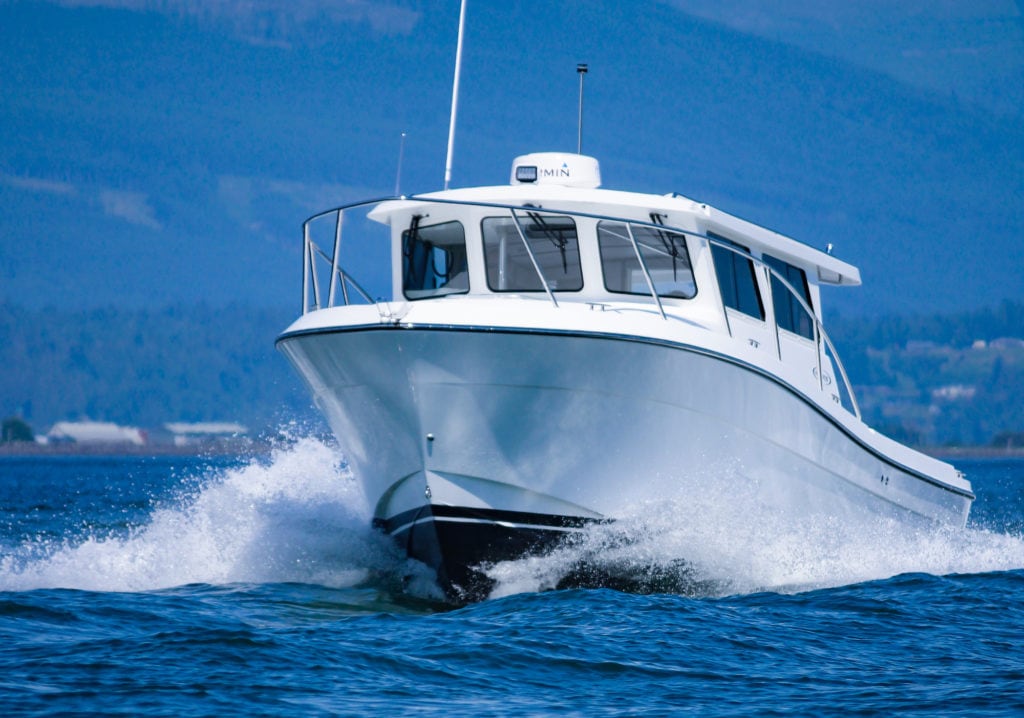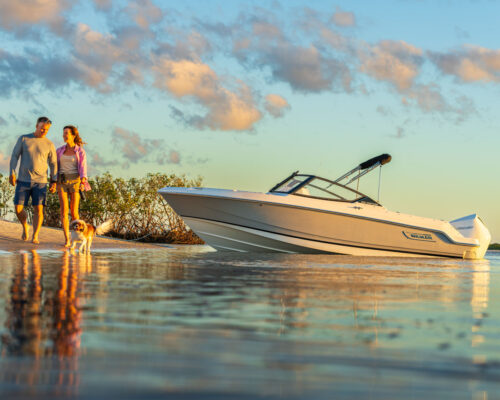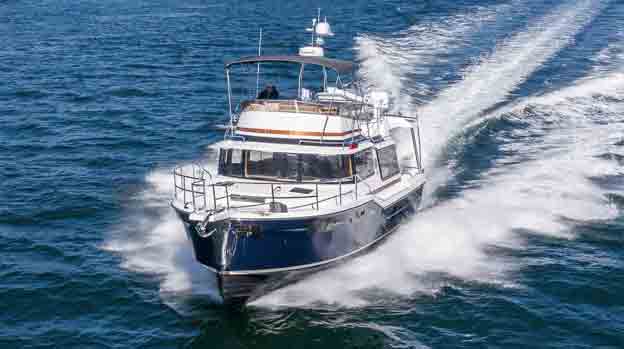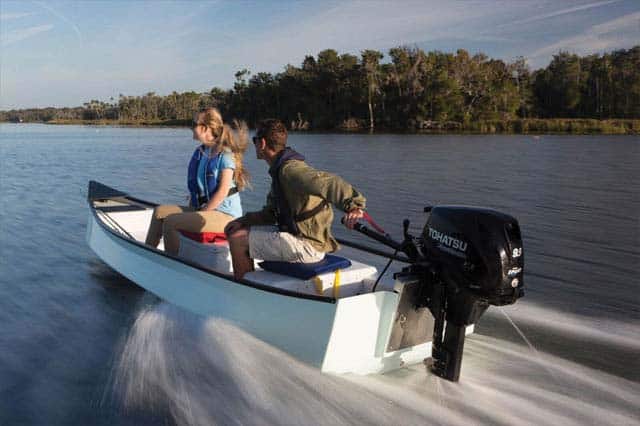Ocean Sport’s Roamer 30 is a classic Pacific Northwest vessel with the region’s trademark backward-sloping pilothouse windshield for shedding rain and spray. She offers a huge cockpit built for fishing and a comfortable pilothouse/saloon for cruising. Obvious clues to the first use include an 8-rod rocket launcher on the aft end of the cabin top, cockpit sole fishboxes, and a large livewell in the center of the transom. For the second, note the fresh water and waste capacities, 80 gallons and 35, respectively, and the fuel capacity of 400 gallons. They are generous for a compact 30-foot vessel with outboard power.
The key to the design lies in the home waters for the vessel and the way folks use it out there. Originally built in LaConnor, Washington, on Skagit Bay about 50 miles north of Seattle, Ocean Sport boats now come from the Nordic Tug plant nearby in Burlington. Skagit Bay opens to the Queen Charlotte Islands, with the southeast end of Vancouver Island, British Columbia, on the other side of them. To the north lies the Strait of Georgia, the open waters of Haida Gwaii, and the Alaska Inside Passage. Yes, families and groups of friends take off in boats like these on cruise/fish adventures for a week at a time, and yes, those boats have to be ready to run hard through serious seas and maneuver in heavy currents.
Now think about the uses to which a fishing/cruising family or couple could put this boat on the Chesapeake. By the way, the cabin top is plenty large enough to stow kayaks, paddleboards, or even a couple of canoes for exploring creeks, coves and marshes. Consider a week long expedition from Annapolis to Havre de Grace and the mouth of the Susquehanna, with stops in places like Dundee Creek going up and Still Pond on the way home. Or a run down the Potomac from Alexandria to Point Lookout, with stops in Potomac Creek, Nomini Creek, the Yeocomico, St. George’s Island and Cobb Island. From Solomons, run across the Bay to Deal Island, Smith Island, Crisfield, Tangier, Onancock and back. From Hampton, run across the James to Smithfield and then up the river to Jamestown and the Chickahominy. The possibilities go on and on, with scenery, history and richly varied fishing opportunities.
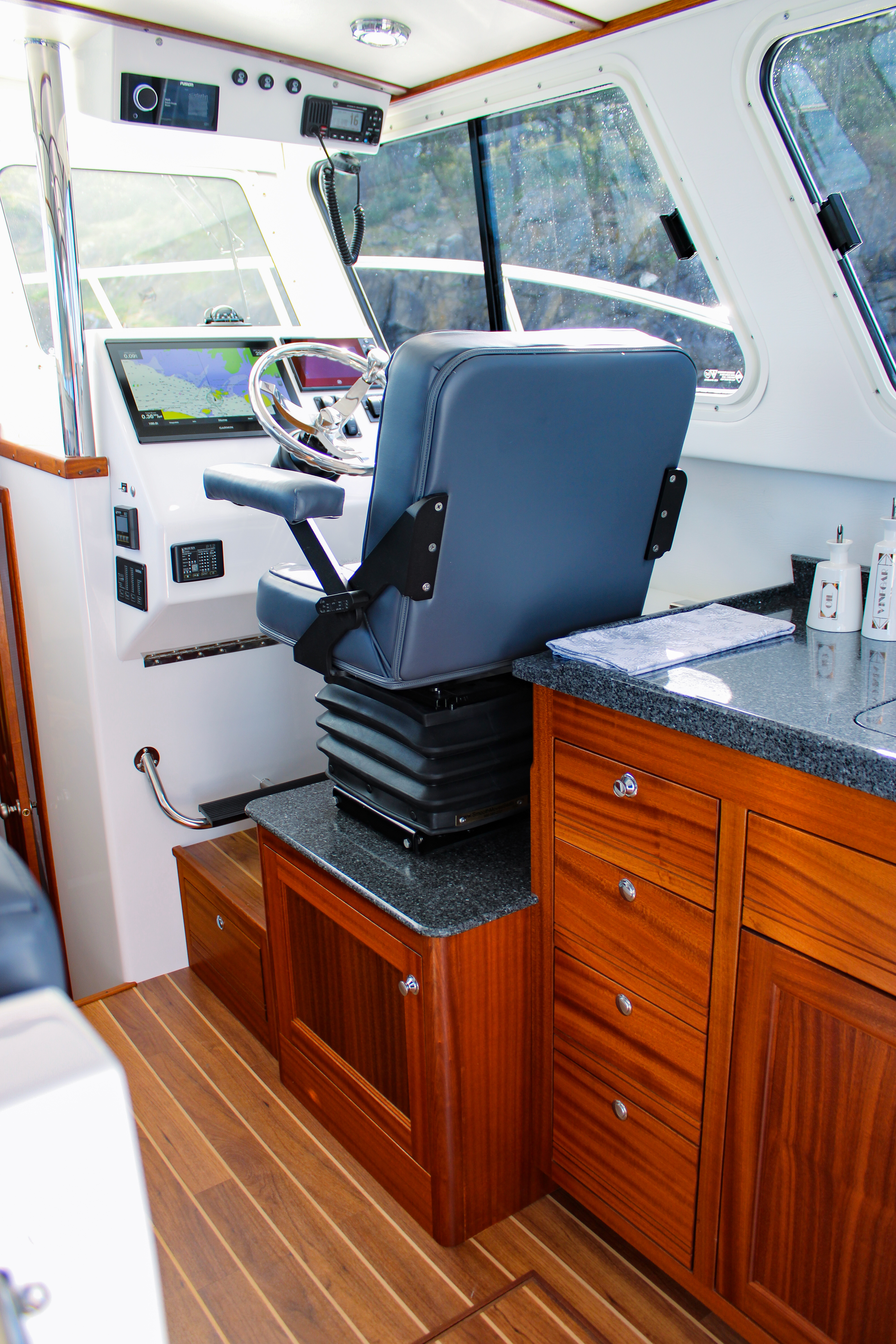
Amy Jamison Photography
Power for the Roamer 30 is a pair of big outboards on a large bracket. Our test boat, from Seattle Yacht Sales in Annapolis, mounted twin 350-hp Mercury Verados that gave her optimum cruise at 27 knots (4500 rpm), burning 27 gallons per hour. Conservatively, her range computes to 360 nautical miles. She’s a long-legged boat. Top speed, at 6200 rpm, was 39 knots. (We do note that the test boat’s 350s were Mercury’s supercharged inline six-cylinder engines that have since been replaced after an 18-year run. They’re proven engines, but Merc’s new 300-hp V-8s, while powerful, are less thirsty. The 300s also turn larger-diameter propellers [16″ vs. 14.5″], so they generate more thrust. With them, expect more efficient cruise in the mid-twenties and a top end around 35 knots.)
The Roamer 30’s spacious cabin allows for three separate sleeping areas, one in the forward V-berth, one in the aft cabin, and one in the saloon. The full galley features a refrigerator/freezer, propane cooktop, microwave/convection oven, Corian counter tops, a deep sink and quality hardwood accents. The full standup head is equipped with an electric toilet, sink and shower. The cockpit is large enough to double as a dance floor. Add several folding chairs and it becomes a natural spot for morning coffee or watching sunsets.
Test day off Annapolis did not offer seas to challenge the Roamer 30, but soft landings in powerboat wakes gave a hint of how easily her sharp bow sections and running bottom’s 20-degree deadrise would come down on gnarlier stuff. She maneuvered readily in simulated jigging maneuvers around Bay Bridge pilings and over the Severn River’s restoration oyster reefs. The big Mercurys purred as we worked the cockpit helm while watching the Garmin 8612 electronic display mounted there.
That large cockpit lends itself to jigging, bait fishing and trolling. The transom holds a 30-gallon bait tank, with raw- and freshwater washdown bibs to port and a stout door to starboard leading to a broad transom platform/engine bracket. The gunwales hold two vertical rodholders per side, with space for downriggers. Padded bolsters line the inner edges, with fiberglass toerails/shelves for gear like boathooks. A tackle box folds out of the cockpit side to port, and the aforementioned eight-rod rocket launcher mounts on the after edge of the cabin top.
Under the sole are four large storage lockers with drop-in bins for icing fish and storing safety gear, plus two 12-volt cranking batteries and four 6-volt deep-cycle house batteries. We’d wish for more rodholders, including lockable storage inside, a workstation for rigging lures and bait and more tackle storage. A handy owner could answer those queries easily. A step on each side of the cockpit leads to an 8-inch-wide side deck, with handrails all the way to the foredeck, as well as access to the cabin top for deploying paddlecraft. The foredeck holds an anchor bracket, windlass, and locker for chain and rode, with backup controls at the helm.
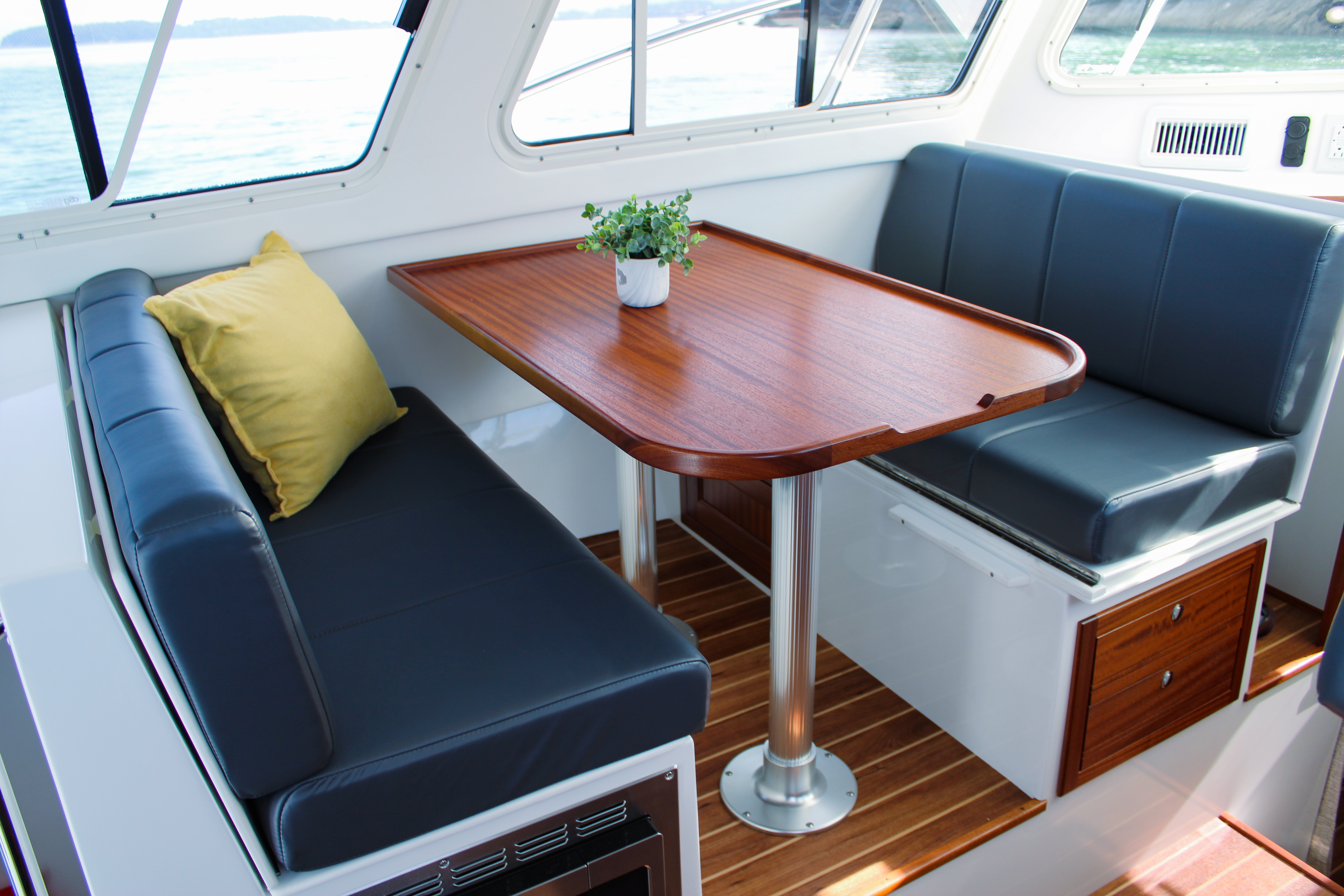
Amy Jamison Photography
For cruising, the Roamer 30 provides a V-berth with storage in the forward cabin, a cedar-lined hanging locker there, and an enclosed head with a shower wand. Headroom is six foot two in the cabin and six feet in the head. The pilothouse/saloon offers another handrail overhead, a sign that the Roamer was built for safety in rough seas. The helm to starboard features a shock-absorbing chair. Electronics include a 16-inch Garmin electronic display connected to AIS, VHF, autopilot and radar. The dashboard tilts for access to wiring. Aft of the helm is a galley with storage cabinets, AC/DC refrigerator, a stainless sink and faucet, a cutting board and a two-burner propane stove. To port is a dinette that seats four and converts to a double bunk. The forward seat is reversible to provide a companion bench while underway. The after seat’s base holds a microwave/convection oven. Aft of the dinette is the entrance to the double berth cabin tucked underneath the seats and table. Heating and air conditioning are available.
For daily checks and maintenance, there’s a lighted mechanical room, accessible through a hatch in the saloon’s sole. It holds an inverter/charger, a 6-gallon water heater, the main freshwater pump, head plumbing, a midship bilge pump and access to the boat’s freshwater tank. Our test boat was hull no. 3 of the new series built by Nordic Tug, and her craftsmanship was excellent. It’s easy to see how the Ocean Sport Roamer 30 fits Pacific Northwest fishing/cruising missions, but it’s not hard at all to see how well it would fit the Chesapeake as well.
Nordic Tugs builds the Roamer 30 and its stretched sister, the Roamer 33, to the same high standards of its own tugboat yachts. The price for our well-equipped test boat with Twin Mercury 350 Verado Outboards is $539,500.
Editor-at-Large John Page Williams is a fishing guide, educator, author and naturalist, saving the Bay since 1973.
OCEAN SPORT ROAMER 30
LOA: 30’3″
Beam: 10’9″
Draft: 35″
Weight: 12,500 lb. (dry)
Transom Deadrise: 20 degrees
Bridge Clearance: 10’1″
Fuel Cap: 400 gal
Water Cap: 80 gal
Waste Cap: 35 gal
Max Power: 800 hp
For additional information, visit www.oceansportboats.com and the Chesapeake’s Ocean Sport dealer, Seattle Yachts in Annapolis, www.seattleyachts.com.

